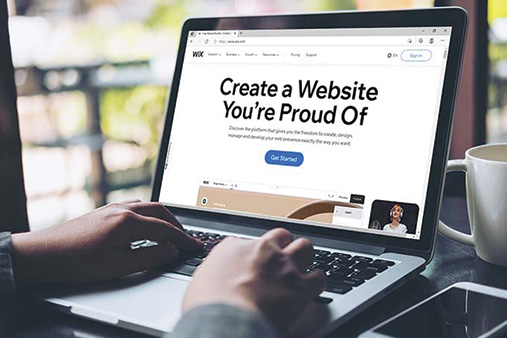What Makes a Good Website: A Guide to Website Design
Your website is an introduction to your business, so it’s vital that it makes a good impression. Besides exceptional content and aesthetically pleasing graphics, a good website needs a few other features to stand out.
Keep reading to learn about the five effective features of good website design. Use these to help turn an average business site into a great website.
Make sure your website builder offers the features you need. Check out our Best Website Builder Review to learn more.

Features of a Good Website
While you should consider many features when creating your business website, we’ve rounded up some of the most important. Use these five qualities to improve your website’s search engine rankings and optimize good web design.
Page Speed
Page speed is the amount of time it takes a web page to load fully. The average website’s pages load in three to five seconds, but you should really aim for no more than three seconds.
Several factors impact page-loading speed, including a website’s server, the web page file size, and image compression. Google views page-loading speed as a search engine optimization (SEO) ranking signal so the faster your site loads, the higher it’ll rank within Google’s search results.
Before you start optimizing your site for speed, set a page-loading time goal. Using Google’s ideal page-loading speed as a benchmark is a good place to start because it has the largest database of sites. But, remember that the algorithms behind Google statistics often indicate the performance levels of an “ideal” site based on web user behavior and not the actual loading times of most sites.
While three seconds may represent the ideal page-loading speed, most sites get nowhere near that. After analyzing more than 900,000 mobile ad landing pages across 126 countries, Google found 70% of the pages took nearly seven seconds to display their visual content. Google also found that mobile landing pages take an average of 22 seconds to load.
Clearly, the average page-loading speed is much longer than what Google considers ideal because its research shows web users abandon 53% of visits if a mobile site takes more than three seconds to load. Given website visitors’ increasing impatience, it’s essential that your website can keep them there after they arrive.
If you make an effort to increase your page speed to an acceptable level, you’ll likely gain a competitive edge in terms of user experience. Start by using these tools to measure the speed of your website:
So how do you optimize that speed once you know how fast your site loads? The best place to start involves your site’s hypertext markup language (HTML), cascading style sheet (CSS), and JavaScript programming language files. By “minifying” and combining these files, you will reduce not only their size, but also their total number.
You can minify and combine files in several ways. First, plugins like WP Rocket for WordPress sites can make this process fairly simple. Check out the Best Plugins for a WordPress Site to learn more about how to optimize the user experience.
Another easy way to reduce page-loading times involves compressing your image files. The gzip software application, for example, will locate strings of similar code in your image files and then temporarily replace them to make the files smaller.
Having a fast web host helps guarantee fast load times. Read our Best Web Hosting Providers Review to learn more.
Security
Adding security features to your business website not only protects your information, it lets your visitors know it’s safe to view and shop on your site.
A secure sockets layer (SSL) certificate not only verifies the identity of a website’s owner, but also the strength of the encryption used when someone connects to that website from a personal device. SSL certification is a necessary security measure for any business that collects information from its website visitors.
Different SSL certificates provide different levels of security, depending on the type of protection and security features your website and its users need. If your website accepts online payments, for example, you’ll need more security. But, even simple business websites may fall victim to cyberattacks that can cause marketing disasters when hackers use stolen information to send spam emails.
All SSL-protected websites display the “https://” prefix in a web browser’s URL address bar. That means users will see the validity and trustworthiness of your site the moment they enter.
Importantly, your website’s SSL certificate must come from a credible source. Make sure you obtain it from a Certificate Authority (CA) — organizations entrusted with verifying the identity and legitimacy of websites.
Let’s Encrypt is one popular CA that offers free SSL certificates in the interest of creating a safer internet. You also can purchase an SSL certificate from a domain name registrar or web hosting provider, such as GoDaddy, Bluehost, and HostGator. You’ll then have to configure your certificate on your web host or your own server if you host your website yourself.
Branding
Having cohesive branding for your business and website is one of the easiest ways to provide brand awareness to future clients and customers. There are many ways to do this, from having a great color scheme, to utilizing the best fonts, to creating a fantastic logo. For the purpose of this article, we will focus on an often overlooked piece of website branding: the favicon.
Favicons are the small, square images displayed before the URL in a browser’s address bar, on the left side of a browser’s tabs, and next to a site’s name in a user’s bookmark list. Internet browsers use them to provide a graphical representation of the sites users visit.
Usually just a miniature logo or brand image shrunk down to 16 by 16 pixels, favicons can feature any image that represents a specific website. These useful images not only help users remember a site’s brand, but also find a specific site more easily when they have multiple browser tabs open or a long bookmark list.
To create a favicon for your website in minutes, use a tool like Favicon CC or RealFaviconGenerator.
Responsive Design
Responsive design allows websites and web pages to display properly on all devices by automatically adapting to a device’s screen size — from desktops and laptops to tablets and smartphones. This design approach delivers an optimized browsing experience, which is increasingly important because people now conduct nearly 60% of all online searches using a mobile device.
If you’re unsure if your website uses responsive design, test it with a tool like Google’s Mobile-Friendly Test. Another way to see how your site displays on different platforms is to resize your browser window and watch how it behaves on different mobile break points. This shows you how your website’s elements appear on devices with different screen sizes.
If you’re still in the process of building your website, WordPress offers many mobile-responsive themes. Read our review of the Best WordPress Themes to learn about the most popular options. Before you choose a theme for your site, check the description box to see if responsive design is one of its attributes. This will save you a lot of hassle over time — especially if you lack computer coding expertise.
Make sure your website builder comes equipped with responsive design. Read our Best Responsive Website Builders guide to find the right fit.
On-Page SEO
On-page SEO — also called on-site SEO — refers to the practice of optimizing web pages to improve a website’s search engine rankings and earn more organic traffic.
Beyond publishing relevant, high-quality content on your site, on-page SEO includes optimizing your headlines, images, and HTML tags (e.g., titles, subheads, and meta descriptions). It also requires ensuring your website has a high level of expertise, authority, and trustworthiness.
On-page SEO is important because it not only helps search engines understand your website and its content, but also identify whether it’s relevant to what a user seeks. With some effort, on-page SEO strategies can boost your website’s traffic and search engine rankings.
Keep the following in mind as you approach on-page SEO for your site.
Target Keywords
When writing content, make sure your topic matches the search intent of people using your target keyword(s). This is vital because pages that don’t satisfy user intent don’t rank well.
Always keep your end user in mind so you can give them the answers and information they seek. If your site doesn’t deliver worthwhile content, people will click away quickly. A high bounce rate — the percentage of people who visit your site, but leave without viewing additional pages — will negatively affect your SEO.
Before you develop new content, check the Google search results for your chosen keywords and then match your content to the same user intent. In addition, include your target keyword(s) in your web page’s URL, title, and heading because research shows articles that do this rank higher than those that don’t.
Intriguing Content
You also should focus on ensuring your site offers enjoyable, engaging content. Why? Because search engines like Google rely on complex algorithms to determine what a page is all about and then rank it appropriately.
Content that provides a better user experience will help your site rank higher in search engine results, but don’t forget that you’re writing content for people and not search engines.
Images
Interesting, eye-catching images can make your website more appealing and entice users to spend more time there. Optimizing your images will help you make the most of this valuable SEO asset as long as you pair each of them with descriptive titles and alt text.
Headings
Using headings in your site’s text will help structure your content into a clear hierarchy, allowing search engines and visitors to immediately see what’s important.
Google loves organized page structures, and headings provide a great way to achieve this. Use the “H1” header tag for a page’s main title and then the “H2,” “H3,” and other header tags for its subtitles. All “H1” header tags should contain your chosen keyword(s) to help search engines understand a page’s content and boost its SEO ranking. As a best practice, aim to match a page’s “H1” header tag with its meta title.
Another vital aspect to consider involves creating an SEO-optimized title. This will trigger multiple search engine ranking factors, such as user intent, the click-through rate, and keyword matching. When creating SEO-optimized titles, keep the following in mind:
- Ensure it matches the intent of your target keyword(s).
- Make it enticing to increase the click-through rate.
- Keep it within the maximum character limit, typically 60 characters.
While a meta description isn’t directly linked to your website’s on-page SEO, it does contribute to other search engine ranking factors like the click-through rate. That means a well-written meta description can make a substantial difference, and the same best practices for crafting titles also apply to meta descriptions.
For more information, read our guide on How To Improve SEO.
Final Thoughts
Creating a good website requires significant time and effort, and it relies on so much more than just high-quality content. While it may seem tedious to implement all of these nitty-gritty features, they can dramatically improve your site’s user experience and search engine ranking when used together.
Creating a great website also means you must consider its structure and how you’ll entice visitors. While each business has distinct needs its website should mirror, remember to also think carefully about How To Structure a Website and How To Drive Traffic To Your Website.


